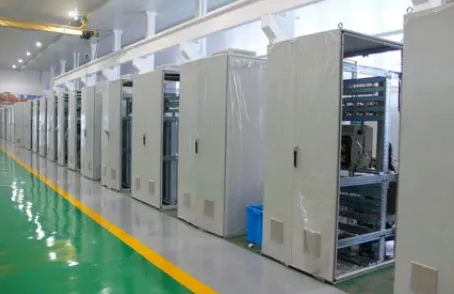
Tension AGC And Its Role In Thin Steel Strip Rolling
In modern steel strip rolling, maintaining precise thickness control while processing thin gauge materials presents unique challenges. Tension AGC (Automatic Gauge Control) has emerged as a critical solution that combines traditional automatic gauge control system principles with advanced roll tension control mechanisms. This hybrid approach is particularly effective for thin strip rolling where conventional hydraulic AGC systems alone may not provide sufficient control.

The AGC system with tension compensation works by continuously monitoring and adjusting both rolling force and interstand tension to maintain consistent strip thickness. Unlike standard automatic gauge control in strip rolling, tension AGC accounts for the complex interplay between roll gap pressure and strip elongation forces. This dual-control methodology enables mills to achieve tighter tolerances on high-speed thin strip production lines.
The Working Principle of Tension AGC Systems
Integration of Force and Tension Control Loops
The AGC controller in a tension-based system operates through two parallel control mechanisms:
Conventional roll gap adjustment via hydraulic or electromechanical actuators
Precise tension control through coordinated speed regulation of adjacent mill stands
These systems use sophisticated algorithms to balance the sometimes competing demands of roll force and strip tension. When thickness deviations are detected by X-ray or laser gauges, the automatic gauge control system first attempts correction through normal roll gap adjustment. However, for thin materials where roll force changes may cause excessive tension variations, the system simultaneously adjusts interstand tension to maintain stability.
Real-Time Adaptive Control Strategies
Modern tension AGC systems employ adaptive control algorithms that continuously learn and predict material behavior. The AGC controller monitors:
Rolling force fluctuations
Strip speed differentials between stands
Tension transducer feedback
Temperature-induced length changes
This data enables the system to anticipate and compensate for disturbances before they result in gauge variations, particularly important when rolling high-strength thin steels that are prone to tension-induced thickness changes.
Key Components of a Tension AGC System
Advanced Sensor Integration
Unlike conventional automatic gauge control in strip rolling, tension AGC requires additional sensors including:
Non-contact tension measurement devices
Multiple thickness gauges at entry, exit, and between stands
High-resolution speed monitors for each roll stand
These sensors provide the comprehensive data needed for the AGC system to make precise tension and force adjustments simultaneously.
Coordinated Drive Control Systems
The heart of effective roll tension control lies in the mill's drive coordination. Modern systems use:
Direct torque control motors with microsecond response times
Synchronized AC drives with common bus voltage systems
Advanced dynamic braking systems for tension maintenance during speed changes
This level of control ensures that tension adjustments don't introduce speed variations that could affect gauge consistency.
Benefits of Tension AGC in Thin Strip Production
Improved Gauge Consistency for Demanding Applications
The combined automatic gauge control system with tension compensation delivers:
±0.5% thickness tolerance even for strips below 0.2mm
Elimination of periodic gauge variations caused by tension fluctuations
Superior surface quality by preventing tension-induced micro-slippage
These capabilities make tension AGC indispensable for producing:
Ultra-thin packaging steels
Precision automotive body panels
Electrical transformer laminations
Enhanced Mill Productivity and Yield
By maintaining optimal roll tension control, mills can achieve:
15-20% higher rolling speeds compared to conventional AGC
Reduced scrap rates from tension-related defects
Longer work roll life due to more stable rolling conditions
The system's ability to handle rapid alloy and gauge changes also improves overall equipment effectiveness (OEE) in job shop environments.
Implementation Challenges and Solutions of AGC
Managing System Dynamics in High-Speed Rolling
The AGC controller must overcome several technical challenges:
Control loop interaction between tension and gauge subsystems
Delay compensation for sensors located downstream from adjustments
Vibration damping in ultra-high-speed applications
Modern solutions include:
Model predictive control algorithms
Adaptive filter technologies
Artificial intelligence-based pattern recognition
Integration with Existing Mill Infrastructure
Retrofitting tension AGC requires careful consideration of:
Drive system upgrade requirements
Sensor placement optimization
Operator interface modifications
Successful implementations typically involve:
Phased commissioning approaches
Comprehensive operator training programs
Continuous performance monitoring and tuning
The Critical Role of Advanced AGC in Modern Steel Manufacturing
The evolution from conventional automatic gauge control in strip rolling to sophisticated tension AGC systems represents a significant advancement in thin strip production technology. By seamlessly integrating roll tension control with traditional gauge regulation, modern mills can achieve unprecedented levels of precision and productivity.
As demand grows for thinner, stronger, and more consistent steel products, continued innovation in AGC system technology will be essential. The future lies in intelligent, self-optimizing control systems that not only maintain gauge accuracy but also predict and prevent quality issues before they occur. Tension AGC stands as a prime example of how advanced process control continues to push the boundaries of what's possible in steel manufacturing.
-
YWLX’s 1450mm Six-Hi Reversing Mill Goes Live in BangladeshNewsNov.24,2025
-
Adjusting Roll Gap in 6Hi Reversing Cold Rolling Mill for Thin StripNewsNov.13,2025
-
Quality Control Standards for Automatic Gauge Control in Strip RollingNewsNov.13,2025
-
Effect of Skin Pass Rolling on Metal DuctilityNewsNov.13,2025
-
Key Components of a Modern TempermillNewsNov.13,2025
-
Common Wear Patterns of Work Roll in Tandem Cold Mill OperationsNewsNov.13,2025
-
Revolutionary Skin Pass Rolling Technology for Enhanced Steel QualityNewsNov.04,2025










